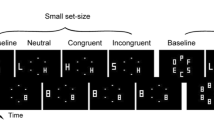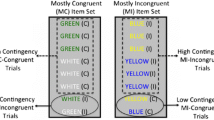Summary
In three experiments, the role of similarity in compatibility effects was investigated. A flanker task was used, in which two flankers (one to the left and one to the right of a centrally presented target) had opposite values on two or three dimensions. Left-right responses were based on the correspondence between the target and the flankers on one dimension. The other dimensions were irrelevant for the task. Manipulation of the overlap pattern between the target and the flankers showed that response efficiency depended on the similarity of the target to the flankers. The similarity model yielded fairly accurate quantitative predictions of reaction times. The implications of these results for theories of compatibility effects are discussed. It is argued that a similarity-based account may be superior to alternative accounts that rely on the notion of congruity.
Similar content being viewed by others
References
Borowiak, D. S. (1989). Model discrimination for nonlinear regression models. New York: Marcel Dekker, Inc.
Eriksen, B. A., & Eriksen, C. W. (1974). Effects of noise letters upon the identification of a target letter in a nonsearch task. Perception & Psychophysics, 16, 143–149.
Estes, W. K. (1982). Similarity-related channel interactions in visual processing. Journal of Experimental Psychology: Human Perception and Performance, 8, 353–382.
Harms, L., & Bundesen, C. (1983). Color segregation and selective attention in a nonsearch task. Perception & Psychophysics, 33, 11–19.
Hasbroucq, T., & Guiard, Y. (1991). Stimulus-response compatibility and the Simon effect: Towards a conceptual clarification. Journal of Experimental Psychology: Human Perception and Performance, 5, 246–266.
Hedge, A., & Marsh, N. W. A. (1975). The effect of irrelevant spatial correspondence on two-choice response time. Acta Psychologica, 39, 427–439.
Kornblum, S., Hasbroucq, T., & Osman, A. (1990). Dimensional overlap: Cognitive basis for stimulus-response compatibility — A model and taxonomy. Psychological Review, 97, 253–270.
Lamberts, K. (in press). Flexible tuning of similarity in exemplar-based categorization. Journal of Experimental Psychology: Learning, Memory, and Cognition.
Lamberts, K., Tavernier, G., & d'Ydewalle, G. (1992). Effects of multiple reference points in spatial stimulus-response compatibility. Acta Psychologica, 79, 115–130.
Medin, D. L., Goldstone, R. L., & Gentner, D. (1993). Respects for similarity. Psychological Review, 100, 254–278.
Nosofsky, R. M. (1986). Attention, similarity, and the identificationcategorization relationship. Journal of Experimental Psychology: General, 115, 39–57.
Shaffer, W. O., & LaBerge, D. (1979). Automatic semantic processing of unattended words. Journal of Verbal Learning and Verbal Behavior, 18, 413–426.
Simon, J. R., & Ruddell, A. P. (1967). Auditory S-R compatibility: The effect of an irrelevant cue on information processing. Journal of Applied Psychology, 51, 300–304.
Simon, J. R., Sly, P. E., & Vilapakkam, S. (1981). Effect of compatibility of S-R mapping on reactions toward the stimulus source. Acta Psychologica, 47, 63–81.
Smith, J. D., & Kemler-Nelson, D. G. (1984). Overall similarity in adults' classification: The child in all of us. Journal of Experimental Psychology: General, 113, 137–159.
Umiltà, C., & Nicoletti, R. (1985). Attention and coding effects in S-R compatibility due to irrelevant spatial cues. In M. Posner & O. S. M. Marin (Eds.), Attention and performance XI (pp. 457–471). Hillsdale, NJ: Erlbaum.
Umiltà, C., & Nicoletti, R. (1992). An integrated model of the Simon effect. In J. Alegria, D. Holender, J. Morais, & M. Radeau (Eds.), Analytic approaches to human cognition (pp. 331–350). Amsterdam: Elsevier Science Publishers.
Wallace, R. J. (1971). S-R compatibility and the idea of a response code. Journal of Experimental Psychology, 88, 354–360.
Wallace, R. J. (1972). Spatial S-R compatibility effects involving kinesthetic cues. Journal of Experimental Psychology, 93, 163–168.
Author information
Authors and Affiliations
Rights and permissions
About this article
Cite this article
Lamberts, K. Towards a similarity-based account of compatibility effects. Psychol. Res 56, 136–143 (1994). https://doi.org/10.1007/BF00419700
Issue Date:
DOI: https://doi.org/10.1007/BF00419700




